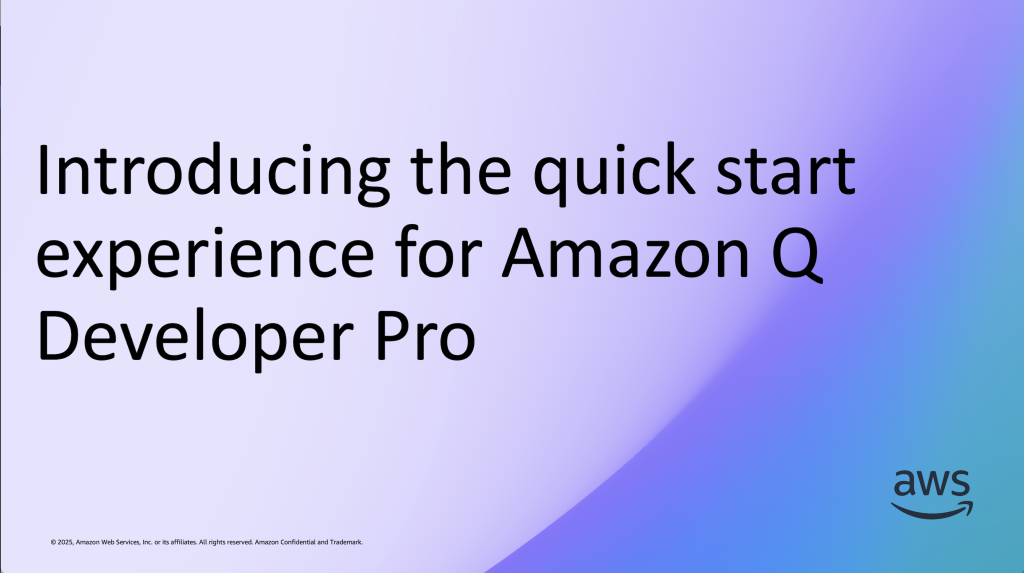AWS DevOps & Developer Productivity Blog
Introducing the quick start experience for Amazon Q Developer Pro
For software developers, development teams and IT Professionals, the Amazon Q Developer Pro Tier is recommended. The pro tier offers higher limits, enterprise administration, an analytics dashboard, code customizations and IP indemnity. In addition, the Amazon Q Developer Pro Tier requires AWS IAM Identity Center. For most production deployments, an organization instances of IAM Identity […]
How generative AI is transforming developer workflows at Amazon
Introduction Software engineering stands at an inflection point. While previous technological shifts enhanced what developers could build, AI is fundamentally changing how we build. Amazon Q has driven a shift in how developers at Amazon approach software development. At re:Invent 2024, our breakout session Unleashing generative AI: Amazon’s journey with Amazon Q Developer (DOP214) shared […]
Validate Your Lambda Runtime with CloudFormation Lambda Hooks
Introduction This post demonstrates how to leverage AWS CloudFormation Lambda Hooks to enforce compliance rules at provisioning time, enabling you to evaluate and validate Lambda function configurations against custom policies before deployment. Often these policies impact the way a software should be built, restricting language versions and runtimes. A great example is applying those policies […]
Customizing C# and C++ with Amazon Q Developer
Amazon Q Developer recently added support for customizing C# and C++ suggestions based on your company’s codebase. This blog post explores how developers can tailor the AI assistant to provide accurate inline suggestions and contextual code understanding for their C# and C++ projects. You will learn how to leverage customizations to boost productivity, streamline development […]
Adopting Amazon Q Developer in Enterprise Environments
Increasing developer productivity has been a persistent challenge for senior leaders over the past decades. With the rise of generative artificial intelligence (AI), a new wave of innovation is transforming how software teams work. Generative AI tools like Amazon Q Developer are emerging as game-changers, supporting developers across the entire software development lifecycle. But how […]
Announcing the AWS CDK L2 Construct for Amazon Cognito Identity Pools
Today we’re announcing the general availability (GA) of the new Amazon Cognito Identity Pool Level 2 (L2) construct in the AWS Cloud Development Kit (AWS CDK). This construct simplifies the creation and management of identity pools, permissions, and provider integrations by providing intent-based APIs that help users securely manage their authenticated and unauthenticated (guest) users […]
Watch the recordings from AWS Developer Day 2025
The AWS Developer Day 2025 showcased how generative AI developer tools from AWS are transforming software development practices, enabling faster building and scaling of cloud software through product launches, leadership insights, and practical demonstrations.
Announcing support for upgrades to Java 21 in Amazon Q Developer
On February 14, Amazon Q Developer announced support for upgrades to Java 21. As a Java developer, I’m excited about this new capability, which will make it easier for me to keep my applications up-to-date and take advantage of the latest language features and performance improvements. In addition, the latest version of Amazon Q Developer […]
Announcing the end of support for Node.js 14.x and 16.x in AWS CDK
On May 30th, 2025, the AWS Cloud Development Kit (CDK) will no longer support Node.js 14.x and 16.x, which reached end of life on 4/30/2023 (14.x) and 9/11/2023 (16.x). This change applies to all AWS CDK components that depend on Node.js, including the AWS CDK CLI, the Construct Library, and broader CDK ecosystem projects such […]
Take control of your code with Amazon Q Developer’s new context features
In this blog post, I dive into the powerful new features of Amazon Q Developer that empower developers to take full control of their development workflow. These features, currently available in Visual Studio Code, allow you to leverage workspace context, explicit context, prompt libraries, and project rules to streamline your software projects, maintain coding standards, […]








